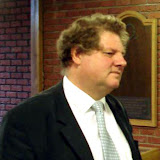
For fourteen chapters all the traffic has been inexorably heading for
It is Cleopas and presumably his wife. A stranger joins them in their walk. This story is apart from anything else a sublime piece of teaching on bereavement counselling: about getting alongside, going at the pace of those suffering, stopping where they stop, and moving on when they resume their journey, listening to their stories, before intervening with interpretation. Theirs is not only a story of disappointed hopes but of disorientation. The testimony of the women that the tomb was empty and that they had seen a vision of angels assuring them that Jesus was alive had made that disorientation. The death of Jesus, though deeply disturbing and a loss of all in which they had placed their hopes, had a finality to it that they might come to live with. This new development was not believable so was not a ground for hope, yet it was tantalisingly suggestive, enough so to undermine the certainty with which they had begun the day. If the testimony of the women were true, and they were fairly sure it was not, that would place demands upon them that would be even greater than when they had decided to put their faith in him in the first place. To follow in faith one you had seen and eaten with, conversed with and witnessed doing remarkable things had been demanding. But to follow one whom you had seen buried but were told was now alive required a different order of faith altogether, a faith beyond your Richter scale when it came to moving mountains.
The stranger began to unpick scripture. He talked about the Messiah. There was something about his teaching that made them want more. They reached Emmaus, their home village. He went on ahead but they called him back and invited him in. When supper was served the stranger took bread, blessed it and broke it. Suddenly they knew who he was. The painting in the National Gallery by Caravaggio says it all. The table is laid with chicken bread wine and fruit. The fruit is as fruit always is: it has its blemishes and its bloom, its wormholes as well as its refreshing ripeness. But it is placed at the very edge of the picture. The disciple flings his arms wide in a vibrant sign of the cross. The disciple on the left is caught in the act of leaping out of his seat. The fruit is about to come tumbling off the front of the table. The revelation of the crucified Jesus as risen Lord overturns all our tables.
The two disciples set out with the setting sun behind their backs and heads east to benighted

No comments:
Post a Comment